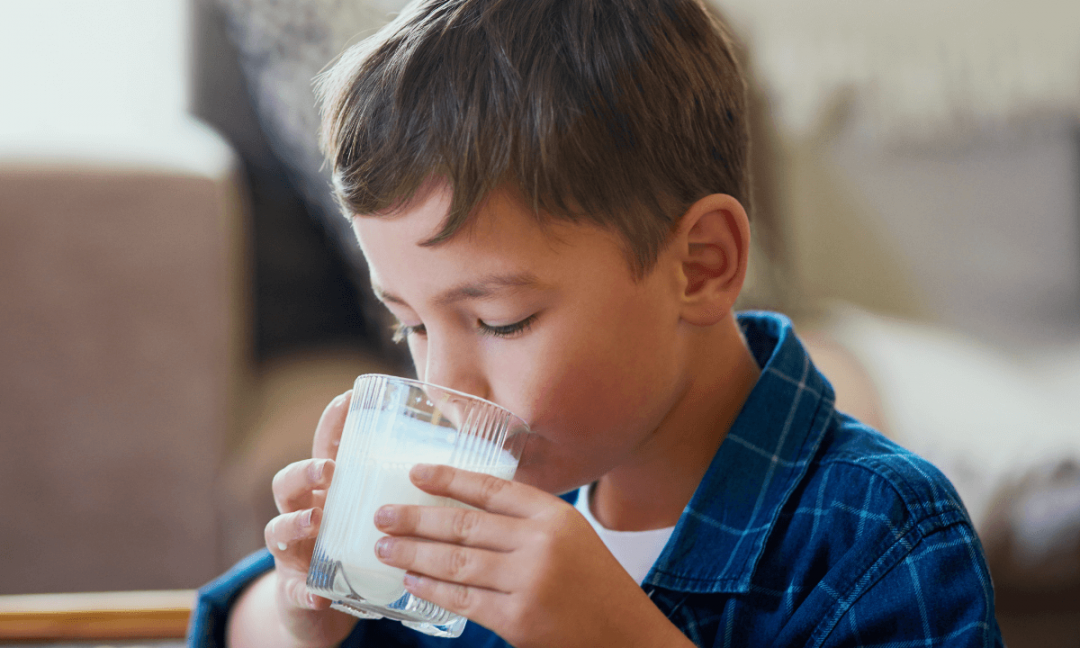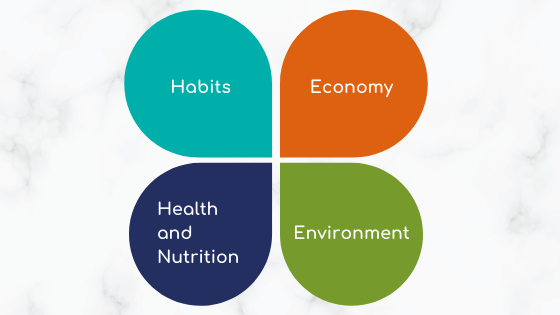
Dairy products in a sustainable healthy diet
Without any doubt, environmental degradation and climate are changing. New modes of consumption appear, new diets become trendy. But are they solutions to tackle these changes ? What means sustainable food?
According to the definition by FAO (Food and Agriculture Organisation): the sustainability of diets goes beyond nutrition and environment to include economic and socio-cultural dimensions. Sustainable Diets are diets with low environmental impacts which contribute to food and nutrition security as well as to healthy life for present and future generations. Sustainable diets are protective and respectful of biodiversity and ecosystems, culturally acceptable, accessible, economically fair and affordable; nutritionally adequate, safe and healthy; while optimizing natural and human resources.[1]

Figure 1: schematic representation of the 4 key components of sustainable diet (adapted from FAO 2010)[1]
The sustainability of diets goes beyond nutrition and environment to include economic and socio-cultural dimensions.
In 2012, a French research group showed a strong positive correlation between quantities of food consumption and greenhouse gas emissions (GHGE) of 1918 adults participating in the French national dietary survey[2]. When the total caloric intakes were reduced to meet individual energy needs, the diet-associated GHGE decreased by either 10.7% or 2.4%. It is therefore essential to combine food consumption and environmental impact.
However, behind this concept, the complexity of sustainability in food and the holistic approach required to assess diet sustainability is hindered by a lack of comprehensive databases compiling relevant food metrics.
Sustainable diet: a difficult balance between environment, health and habits
In 2019, 37 scientists gathered to answer the sustainable diet question. The EAT-Lancet Commission defined 4 “healthy diet” (flexitarian, pescatarian, vegetarian and vegan). They must provide a high contribution of plants (68% of weight and 65% of energy) and low quantities of animal products (25% of weight and 12% of energy). The Eat Lancet Commission report describes a universal healthy reference diet that was developed with the aim to provide a basis for estimating the health and environmental effects of adopting an alternative diet relative to the standard current diets[3].
Following the reference diet involves drastic changes in eating habits.
But, following the reference diet involves drastic changes in eating habits. Moreover, the nutritional efficacy of the “healthy diet” didn’t take into account the contents of vitamin D, total and added sugars, trans fatty acids, DHA or sodium; they induced low levels of calcium, vitamin B2 and B12 ; and they didn’t take into account nutrients bioavailability[4]. In the same time, Barré et Al. concluded that decreasing meat content was strictly needed, but the reduction is less severe when nutrient bioavailability and co-production links were taken into account[5]. EAT-Lancet Commission indicated a theoretical value of 718 mg of calcium from the Reference Diet, a very low value in comparison to those reported in all guidelines. In addition it is very important to highlight that James et Al. estimated that, in the adult population (older than 25 years), 22% of total deaths (11 million total) and 15% of disability-adjusted life-years (255 million total) across 195 different countries are attributable to dietary risks, for non-communicable disease includes low intake of fruits, vegetables, legumes, whole grains, nuts and seeds, milk, seafood n-3 fatty acids, n-6 polyunsaturated fatty acids (PUFA), calcium and fiber[6].
Sustainable diet and nutritional efficiency
In French dietary study INCA3, regarding vitamins and minerals, dairy products are important carriers of calcium, iodine, vitamin D and vitamin B12, especially in children aged 1 to 10 (58%, 44%, 63% and 39% respectively)[7]. In adults and elderly subjects, in the Dutch population the contribution of dairy products to total micronutrient intake was 65%-68% for calcium, 18%-19% for selenium, 3%-4% for iron, 28%-31% for zinc, 6%-7% for copper, 17%-19% for folic acid, 10%-14% for vitamin C, 11%-16% for vitamin D, and 44%-46% for vitamin B(12)[8] .
Dairy products are important carriers of calcium, iodine, vitamin D and vitamin B12.
Sustainable diet and eating habits
Using the cross-sectional French national dietary survey called the “Individual and National Survey on Food Consumption” (INCA2 ), Masset et Al. identified the most sustainable diets already consumed by people in everyday life. A more sustainable diet is represented by a reduction of snacks, sweets and desserts (16% vs 18% of total energy intake), mixed dished (9% vs 12%) and meat, fish and eggs (14% vs 17%). The intake of dairy products was not different between the more sustainable and average diets (10% of total energy content)[9]. More recently, mean food intakes of dairy in the “More‐Sustainable” cluster in European countries was around 250 g per day[10].
The place of dairy products in a healthy sustainable diet
Scientific data showed that dairy products have their place in sustainable food: they are affordable, have an environmental impact on greenhouse gases comparable to plants, and they are integrated into many dietary practices, because they are very good contributors to the nutritional intake of vitamins and minerals. As an essential nutrient in diet, proteins comprising dairy one, plays a central role in the dietary recommendation, they also have a central role in our lives and cultures! Livestock also provides a living for millions of farmers and communities around the world. Milk products have low energy density, are relatively inexpensive, and of high nutritional value. Whereas dairy and sweets are equivalent in terms of price per calorie (in the United States), dairy products are nutrient dense and, therefore, provide nutrients at a lower cost[11].
Eat what is just needed (and waste less) to impact less the planet.
Dairy products have their place in sustainable food: they are affordable, have an environmental impact on greenhouse gases comparable to plants, and they are integrated into many dietary practices, because they are very good contributors to the nutritional intake of vitamins and minerals.
A sustainable diet is a tricky balance, in particular between nutrition and environmental. To date, combining food and environment into a single indicator is still under discussion and there is no consensus. The challenge and the goals is the development of harmonized indicators[12].
Indeed, FAO (2021) has just made a call for experts for the Formation of a research group on environmental and nutritional LCA (Life Cycle Analysis) methodologies[13] and IDF (International Dairy Federation, 2021) has just started with a new work Item to develop Indicators for healthy diets in a sustainable food system.
To find out how Lactalis Ingredients supports the production of sustainable dairy ingredients download our CSR Report 2019.
Sources :
[1] FAO. 2010. « Sustainable Diets and Biodiversity – Directions and solutions for policy, research and actions ». 2010. http://www.fao.org/3/i3004e/i3004e00.htm.
[2] Vieux, F., N. Darmon, D. Touazi, et L. G. Soler. 2012. « Greenhouse gas emissions of self-selected individual diets in France: Changing the diet structure or consuming less? » Ecological Economics 75 (C): 91‑101.
[3]Willett, Walter, Johan Rockström, Brent Loken, Marco Springmann, Tim Lang, Sonja Vermeulen, Tara Garnett, et al. 2019. « Food in the Anthropocene: The EAT-Lancet Commission on Healthy Diets from Sustainable Food Systems ». Lancet (London, England) 393 (10170): 447‑92. https://doi.org/10.1016/S0140-6736(18)31788-4.
[4] Springmann, Marco, Keith Wiebe, Daniel Mason-D’Croz, Timothy B. Sulser, Mike Rayner, et Peter Scarborough. 2018. « Health and Nutritional Aspects of Sustainable Diet Strategies and Their Association with Environmental Impacts: A Global Modelling Analysis with Country-Level Detail ». The Lancet. Planetary Health 2 (10): e451‑61. https://doi.org/10.1016/S2542-5196(18)30206-7.
[5] Barré, Tangui, Marlène Perignon, Rozenn Gazan, Florent Vieux, Valérie Micard, Marie-Josèphe Amiot, et Nicole Darmon. 2018. « Integrating Nutrient Bioavailability and Co-Production Links When Identifying Sustainable Diets: How Low Should We Reduce Meat Consumption? » PLOS ONE 13 (2): e0191767.
https://doi.org/10.1371/journal.pone.0191767.
[6] James, Spencer L, Degu Abate, Kalkidan Hassen Abate, Solomon M Abay, Cristiana Abbafati, Nooshin Abbasi, Hedayat Abbastabar, et al. 2018. « Global, Regional, and National Incidence, Prevalence, and Years Lived with Disability for 354 Diseases and Injuries for 195 Countries and Territories, 1990–2017: A Systematic Analysis for the Global Burden of Disease Study 2017 ». The Lancet 392 (10159): 1789‑1858. https://doi.org/10.1016/S0140-6736(18)32279-7.
[7] ANSES. 2017. « Étude individuelle nationale des consommations alimentaires 3 (INCA 3) Avis de l’Anses – Rapport d’expertise collective ». https://www.anses.fr/fr/system/files/NUT2014SA0234Ra.pdf.
[8] Vissers, Pauline A. J., Martinette T. Streppel, Edith J. M. Feskens, et Lisette C. P. G. M. de Groot. 2011. « The Contribution of Dairy Products to Micronutrient Intake in the Netherlands ». Journal of the American College of
Nutrition 30 (5 Suppl 1): 415S-21S. https://doi.org/10.1080/07315724.2011.10719985.
[9] Masset, Gabriel, Florent Vieux, Eric Olivier Verger, Louis-Georges Soler, Djilali Touazi, et Nicole Darmon. 2014. « Reducing energy intake and energy density for a sustainable diet: a study based on self-selected diets in French adults ». The American Journal of Clinical Nutrition 99 (6): 1460‑69. https://doi.org/10.3945/ajcn.113.077958.
[10] Vieux, F., L. Privet, L. G. Soler, X. Irz, M. Ferrari, S. Sette, S. Raulio, et al. 2020. « More Sustainable European Diets Based on Self-Selection Do Not Require Exclusion of Entire Categories of Food ». Journal of Cleaner Production 248 (mars): 119298. https://doi.org/10.1016/j.jclepro.2019.119298.
[11] Drewnowski, Adam, John Finley, Julie M Hess, John Ingram, Gregory Miller, et Christian Peters. 2020. « Toward Healthy Diets from Sustainable Food Systems ». Current Developments in Nutrition 4 (nzaa083). https://doi.org/10.1093/cdn/nzaa083.
[12]Eme, Paul Eze, Jeroen Douwes, Nicholas Kim, Sunia Foliaki, et Barbara Burlingame. 2019. « Review of Methodologies for Assessing Sustainable Diets and Potential for Development of Harmonised Indicators ». International Journal of Environmental Research and Public Health 16 (7). https://doi.org/10.3390/ijerph16071184.
[13] FAO. 2021. « Formation of a research group on environmental and nutritional LCA methodologies – Call for experts ». https://www.lifecycleinitiative.org/wp-content/uploads/2021/03/Research-Group-on-environmental-and-nutritional-LCA-methods-ToRs.pdf















